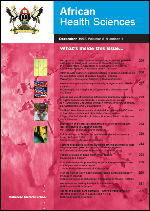
|
African Health Sciences
Makerere University Medical School
ISSN: 1680-6905
EISSN: 1680-6905
Vol. 18, No. 1, 2018, pp. 48-54
|
 Bioline Code: hs18008
Bioline Code: hs18008
Full paper language: English
Document type: Study
Document available free of charge
|
|
|
African Health Sciences, Vol. 18, No. 1, 2018, pp. 48-54
| en |
First study of susceptibility and resistance status to pyrethroids insecticides in Anopheles (Cellia) sergentii  (Theobald, 1907) from Southern Tunisia (Theobald, 1907) from Southern Tunisia
Tabbabi, Ahmed & Daaboub, Jabeur
Abstract
Background: Insecticide resistance is an important threat to malaria control. Anopheles (An.) sergentii proved to be the number
one vector in the oases and may be of a particular interest in projection of the future trends of the disease in Tunisia.
Objectives: Resistance status to pyrethroids insecticides in An. sergentii was evaluated for the first time in Tunisia.
Methods: Diagnostic resistance tests to pyrethroids insecticides were conducted on late third and early fourth larvae of An.
sergentii collected in Southern Tunisia.
Results: The level of resistance to permethrin and deltamethrin varied from 1.9 to 5.77 and from 2.75 to 4.63, respectively.
The highest resistance was recorded in sample # 3 to the two used insecticides. Synergists showed that esterases and glutathione-S-transferase
were not involved in the resistance to any of the evaluated insecticides. In contrast, cytochrome-P450 monooxygenases
played a role in the detoxification of two among three studied samples. Positive correlations between larval tolerance
to both Permethrin/DDT and Deltamethrin/DDT were recorded indicated target site insensitivity.
Conclusion: Continued monitoring of insecticide susceptibility and generating complementary data on mechanisms of resistance
using molecular and biochemical methods is essential to ensure early detection of insecticide resistance in potential malaria
vectors in Tunisia.
Keywords
Anopheles sergentii; Pyrethroids insecticides; Tunisia
|
| |
© Copyright 2018 - African Health Sciences
|
|
